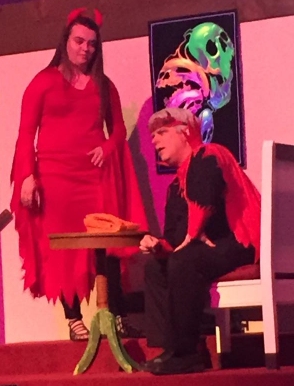
His sermon was based on three gardens (Eden, Gethsemane, and the Garden Tomb). His overall message was that the tragedy of what happened at the Garden of Eden has been erased by the sacrifice that started at the Garden of Gethsemane and the victory of the resurrection that took place at the Garden Tomb. It’s difficult to write skits about such well-known events, so I often try to write from a unique perspective. With the pastor’s permission, I decided to write these skits from the Devil’s perspective. The four skits will appear below.
This was all laden with emotion for me, because it was the first time I had done a skit since my right-hand man in the church’s drama ministry passed away. I wanted to do something that made it clear how important this step was, so I hesitantly asked his teenage daughter, Emma, if she would do the skits with me. She agreed and did a great job. I really couldn’t have asked for it to go much better, and the congregation appreciated both the content of the skits and the significance of the event.
Feel free to use these skits in any way that the Lord leads. If possible, I would like a credit, but the most important thing is to use them to minister to the Body of Christ.


